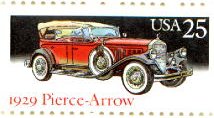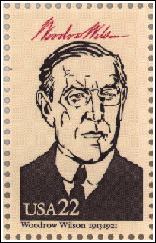Main Events of the 20th Century
Since the focus of this work lies on the role the railroads played in the nineteenth century, the events in the twentieth century will be discussed only minimally. For the railroads, this century was a time of more great mergers, more government regulation, more strikes (in 1946 and 1951), considerable competition from other means of transportation, and an emphasis on tourism as far as passenger travel was concerned.Although the railroads remained America's most important transportation system for the first few decades of the twentieth century, their 'glory days' were over. The railroads did not 'own' the twentieth century like they had owned the late nineteenth. Travel by car, tour bus, and soon, by plane, started the decline of passenger travel, while the railroad industry was also threatened with the emerging economical trucking industry, which promised to take up a large share of the freight business[80].
 Earlier there had already been some competition from elevated as well
as subway railway lines. Boston was the first city to complete a subway system,
in 1898. Another innovation was the electric-powered railroad. By the turn of
the century many of the nation's cities were also linked with suburbs and other
nearby urban centers with electric train lines. Reaching a peak of about 15,000
miles of line in 1916, the electric interurban railroads then met rising competition
from automobiles. The interurban lines were abandoned quickly. By 1914 the number
of automobiles registered in the United States was approaching 2 million. The
popularity of the automobile, the coming of mass production, and
Earlier there had already been some competition from elevated as well
as subway railway lines. Boston was the first city to complete a subway system,
in 1898. Another innovation was the electric-powered railroad. By the turn of
the century many of the nation's cities were also linked with suburbs and other
nearby urban centers with electric train lines. Reaching a peak of about 15,000
miles of line in 1916, the electric interurban railroads then met rising competition
from automobiles. The interurban lines were abandoned quickly. By 1914 the number
of automobiles registered in the United States was approaching 2 million. The
popularity of the automobile, the coming of mass production, and
 the rapid development of automotive technology made it clear that the next great wave
of development in the transport sector would follow different lines than those of
the railroad era. Although still in its infancy, another major competitor for the
railroads was the airplane. The first regular air service in America was instituted
in Florida in 1914[81].
the rapid development of automotive technology made it clear that the next great wave
of development in the transport sector would follow different lines than those of
the railroad era. Although still in its infancy, another major competitor for the
railroads was the airplane. The first regular air service in America was instituted
in Florida in 1914[81].
These years of railroad decline, however, led to a new effort for increased efficiency. Locomotives and equipment were improved, the loading and unloading of freight cars became a science, and mileage was increased per freight car. This was also the age of luxury passenger travel. In 1934 for example, the Union Pacific introduced the Streamliner "City of Salina," an ultramodern, high-speed diesel powered train set which included a coach and a combination coach-buffet. New sleeping cars came with a range of accommodations, including a newly designed roomette, in addition to sections, bedrooms, compartments and drawing rooms. Air-conditioned dining cars used fine china, silver and linen[82].
In 1915, Congress authorized a federal railroad from the Gulf of Alaska to the Yukon River. Woodrow Wilson chose the route from Seward to Fairbanks; Warren Fairbanks drove the symbolic golden spike in 1923. The Alaska Engineering Commission (AEC) supervised forty-five hundred workers on the federal payroll at the height of construction. The AEC also planned, built, and managed the new city of Anchorage from 1915 to 1920. In July 1915, the government auctioned off 655 lots, with strict rules forbidding their development for 'immoral' purposes. Just a few months later, Anchorage already resembled a small town, with retail stores, restaurants and lawyers[83].
The railroads played an important part during World War I and II, transporting supplies
and personnel. The position of the railroads at the beginning of WWI was weak. For years,
the cost of railroad operation in maintenance, materials, and labor had been increasing.
The war brought temporary prosperity with the enormous stimulation of the freight business
in 1915 and 1916, but the rising cost of material and higher wages absorbed much of the
profits. The railroads could not meet the pressure of war needs. The War Industries Board
created a five-member committee, the Railroads War Board, with the task of obtaining
cooperation in sharing of equipment, amongst other activities. This voluntary
 program proved inadequate, and in December 1917 President
Wilson ordered an outright government take-over of the railroads. Congress mandated
return of the roads to the companies not later than 21 months after hostilities had
ended[84].
In WWII the railroads did such a good job under the direction of the Office of Defense
Transportation that the government found it unnecessary to extend further controls.
Railroads reported that they had moved two and a half times the number of ton-miles of
freight in 1944 that they had in 1929, and four and a half times the passenger
traffic[85]. After the
war there was another decline in passenger service, when soldiers came home, bought cars
in large numbers, and used them on the country's improved
roads[86].
program proved inadequate, and in December 1917 President
Wilson ordered an outright government take-over of the railroads. Congress mandated
return of the roads to the companies not later than 21 months after hostilities had
ended[84].
In WWII the railroads did such a good job under the direction of the Office of Defense
Transportation that the government found it unnecessary to extend further controls.
Railroads reported that they had moved two and a half times the number of ton-miles of
freight in 1944 that they had in 1929, and four and a half times the passenger
traffic[85]. After the
war there was another decline in passenger service, when soldiers came home, bought cars
in large numbers, and used them on the country's improved
roads[86].
By the 1960s, the passenger train was rarely considered as a means of travel anymore. In October 1971 Congress passed the Rail Passenger Service Act, which created Amtrak, a private company. On May 1st 1971 it began managing a nation wide rail system dedicated to passenger service[87]. Dee Brown, writer of Hear That Lonesome Whistle Blow (1977), has his own opinion on Amtrak: "… Now only a handful of efficiently operated railroads remain. Most of the passenger traffic has been subsidized by the people's money in a bureaucratic absurdity known as Amtrak, which attempts to run passenger trains over privately owned tracks so worn out that they would not have passed inspection during construction of the first transcontinental railways a century ago[88]". "Today, in the 1970s, Amtrak offers passage from New York to San Francisco in seventy-four hours (if the trains run on time) on an obsolete system that offers neither safety nor elegance[89]". Then again, Brown wrote this over twenty years ago.
By the end of the twentieth century, the emphasis in passenger travel lies mostly on luxury rail journeys for adventurers or railway fanatics. Trips to the Grand Canyon, the American and Canadian Rockies, the Pacific Coast, or scenic tours of Vermont are offered by a variety of companies throughout the country. This is not a twentieth century novelty. Decades earlier, the major western railroads sought to promote parks along their routes as a way of encouraging transcontinental passenger traffic. Railroad tourism characteristically involved delivering hundreds of wealthy travelers to a single passenger depot, from where they traveled by horse and stage to a large, luxurious hotel. The railroad companies spent large sums on advertising and other promotional packages to show Americans the wonders of the western landscape. Places such as Yellowstone, Yosemite, the Grand Canyon, and most other western parks were introduced to the public in this manner[90].
While the twentieth century is still the era of the automobile and the airplane, it is interesting to speculate on what the future may hold. On this point, John Stilgoe, author of Metropolitan Corridor writes, "if the age of the motorcar ends in a succession of fuel shortages, if Americans look once again to the railroad train for swift, reliable, luxurious travel, the corridor will emerge into public view not as wreckage, but as a wildered antique; something to be restored and modified … Once again, Americans will hearken to the locomotive whistle, the sound of the metropolitan corridor.[91]"
